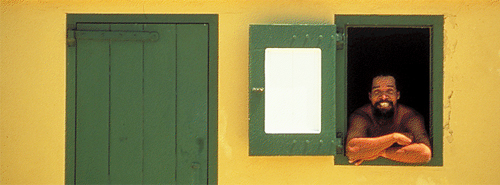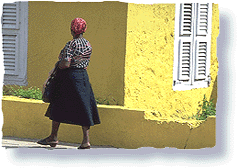| Papiamentu


Origins of the Language | Characteristics of Creole | Words and Phrases
Papiamentu is a form of Creole indigenous to the Dutch Antilles, particularly Bonaire, Curacao, and Aruba, where it is considered the national language. It is also found in occasional use on Sint Maarten, Saba, and Statia. The term is a derivation of the old Spanish verb papear, which means to speak or converse.
Origins of the Language
Although there are numerous theories on the origins of Papiamentu, the most widely accepted explanation is that it is a Portuguese based Creole, traceable to the first contact between the Portuguese and West Africans in the mid-1400s. The Portuguese colonization of the West African coast prompted the evolution of a new language, one containing elements of African language structures and Portuguese vocabulary that allowed the two peoples to communicate with each other.
 Shortly thereafter, the Portuguese commenced the slave trade, shipping human cargo from the West African coast to the Americas. Gathered from all over West Africa, the slaves did not even share a common language, as they spoke dialects that varied considerably by region. To communicate with one another, as well as with the Portuguese, they slowly started to acquire the coastal Creole during the many months they were held in West African ports awaiting passage across the Atlantic. This lingua franca, which became the mother tongue of a new generation, evolved further as it was adapted to the particular linguistic environments in which the slaves found themselves. In many instances, the resulting Creole served as a secret language shared among the slaves, incomprehensible even to those owners who spoke Portuguese. Shortly thereafter, the Portuguese commenced the slave trade, shipping human cargo from the West African coast to the Americas. Gathered from all over West Africa, the slaves did not even share a common language, as they spoke dialects that varied considerably by region. To communicate with one another, as well as with the Portuguese, they slowly started to acquire the coastal Creole during the many months they were held in West African ports awaiting passage across the Atlantic. This lingua franca, which became the mother tongue of a new generation, evolved further as it was adapted to the particular linguistic environments in which the slaves found themselves. In many instances, the resulting Creole served as a secret language shared among the slaves, incomprehensible even to those owners who spoke Portuguese.
Evidence for this theory is found in the guene language, which was brought to Curacao by the first slaves to arrive on the island. Slaves would use it when they didn't want their shons (owners) to understand what they were saying. For a long time guene was neglected by linguists simply because it seemed incompatible with any potential root language. More recently, however, it was found to bear an unmistakable structural similarity to Crioulo, the Portuguese Creoles that are still spoken on the West African coast (in parts of Guinea Bissau, the Cape Verde Islands, Senegal, and Gambia). This resemblance suggests that guene is actually a remnant of the new language from the ports of West Africa, brought to Curacao around the 16th century. Other Portuguese based Creoles, all linked to early regions of Portuguese colonization, include Cafundo (in Brazil), Korlai (near Bombay, India), Macanese (in Hong Kong), Kristang (in Melaka, Malaysia), and Ternateno (in Maluku, Indonesia), and Indo-Portuguese (in Sri Lanka), although only Cafundo shares Papiamentu's West African origins.
Characteristics of Creole
Most nouns have no special form to indicate gender. Gender is created by adding the words homber (man)/machu (male) or muhe (woman) behind the noun: pushi machu - (cat male); mucha homber - (child male).
The nouns do not denote plurality when prefaced with a word with plural meaning: un homber - (one man); dos homber - (two men); un hende - (one person); hopi hende - (many people); un strea - (one star); tres strea - (three stars).
The verbs have no distinction of number: Ami ta bai - (I am going); Nos ta Bai - (We are going).
To indicate time and aspect, verbs use particles which stand on their own: Mi ta bai - (I am going); Mi tabata bai - ( I was going); Mi lo bai - (I will go).
Most times the morpheme that indicates plurality has the same form as the third personal pronoun: nan - (they); muchanan - (children).
The presence of serial verbs: Sinta pensa (un ratu) - Sit and think (for a while); Lanta para wak - Stand up stand look.
Reduplication is used with different functions: pega-pega - (stick-stick) - a reptile that sticks to people; poko-poko - (slow-slow) - careful, very slow, annoyingly slow; tan-ten - (time-time) - in the meantime; pushi-pushi - (cat-cat) - quietly - as when a teenager is sneaking off to meet a date at 2 am.
A preference for the active voice rather than the passive: Nan ta ferf e kas - (They are painting the house); Nan ta straf e muchanan - (They are punishing the children).
Common Words & Phrases
Bon bini - welcome
Kon ta bai - hello
Bon dia - good morning
Bon tardi - good afternoon
Bon nochi - good evening
Si - yes
Danki - thank you
Dushi - sweetheart, sweet
Kome - eat
Bebe - drink
Drumi - sleep
Ayo - good-bye
Unda mi por kome kuminda krioyo? - (Where can I eat local food?)
Bo por mustra mi e kaminda pa Washington Park? - (Could you show me the way to Washington Park?)
Kon ta bai? - (How are you?)
E pomp di gasolin ta habri awor? - (Is the gas station open now?)
un, dos, tres, kuater, sinku, seis, shete, ocho, nuebe, djes - (1, 2, 3, 4, 5, 6, 7, 8, 9, 10)
|


